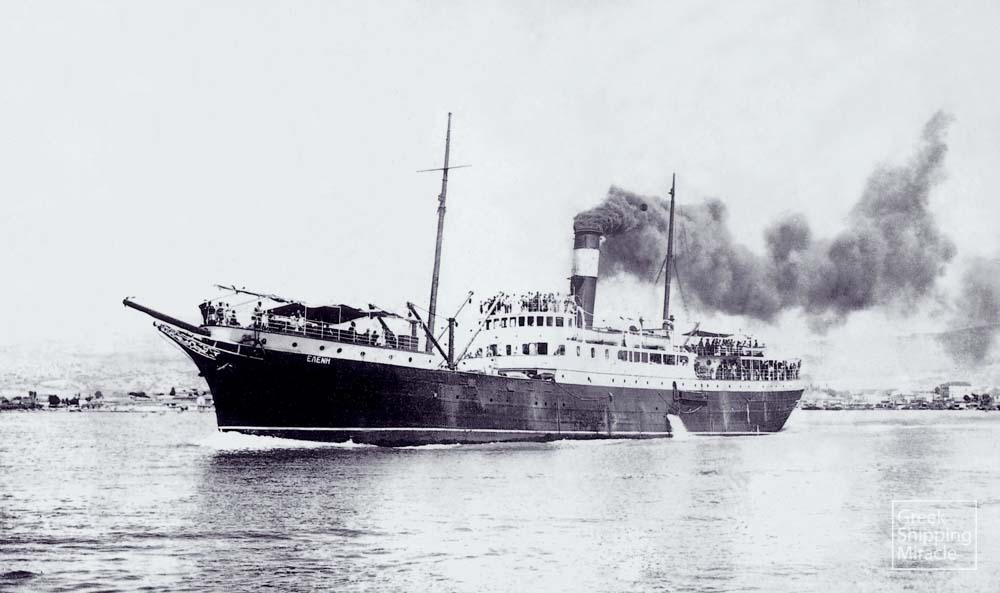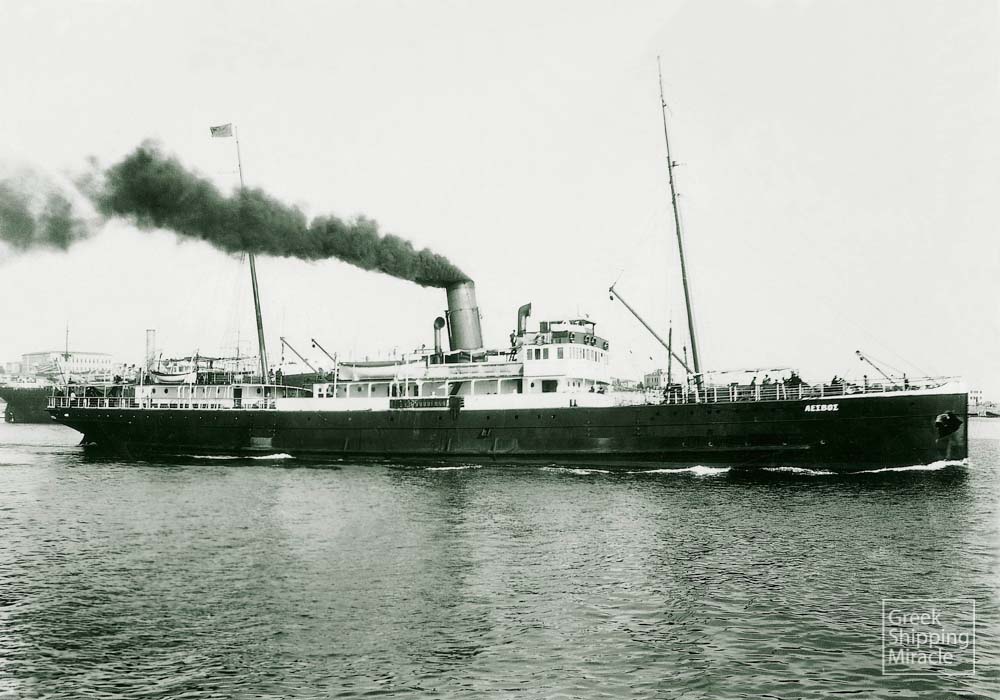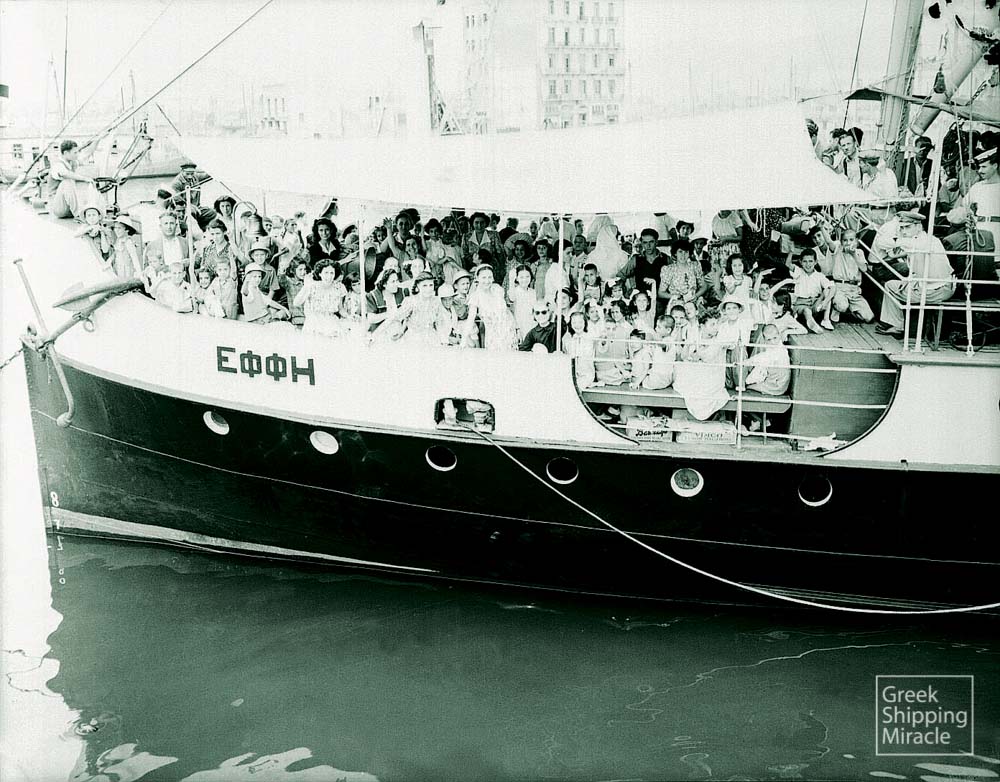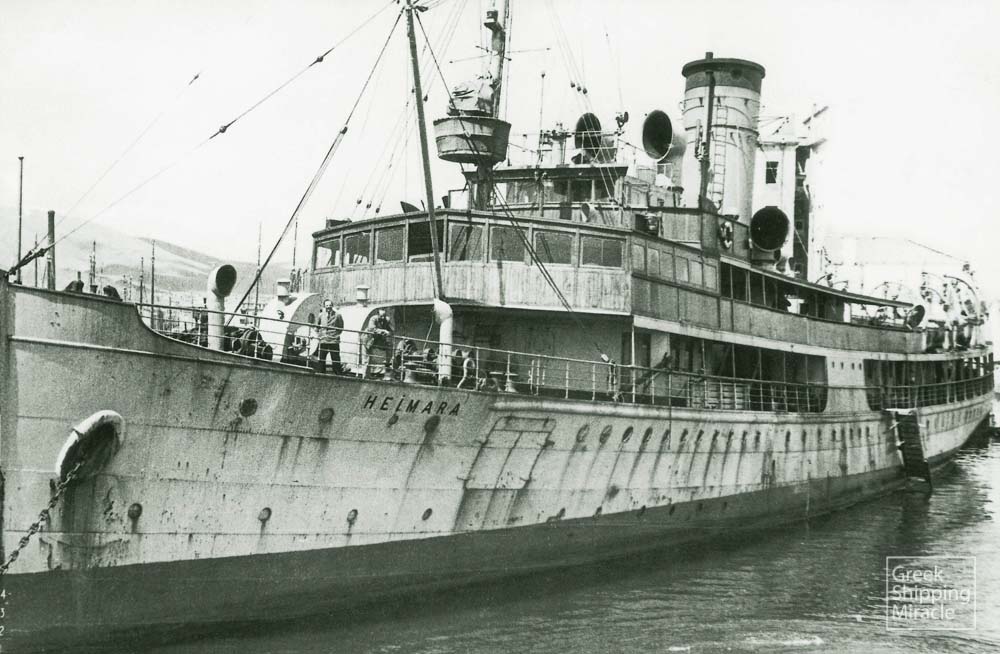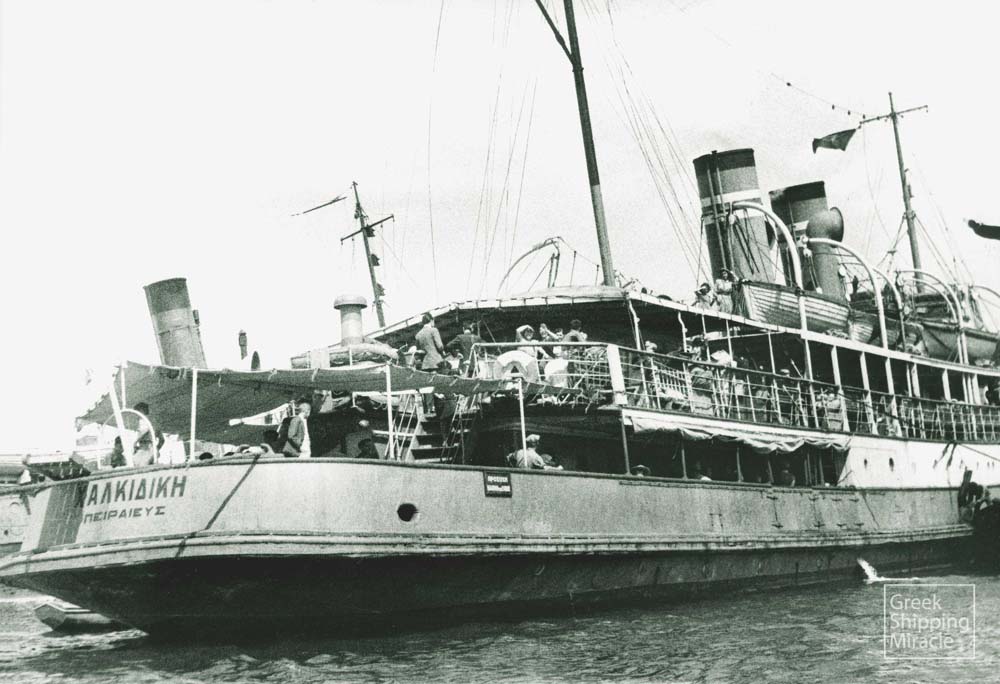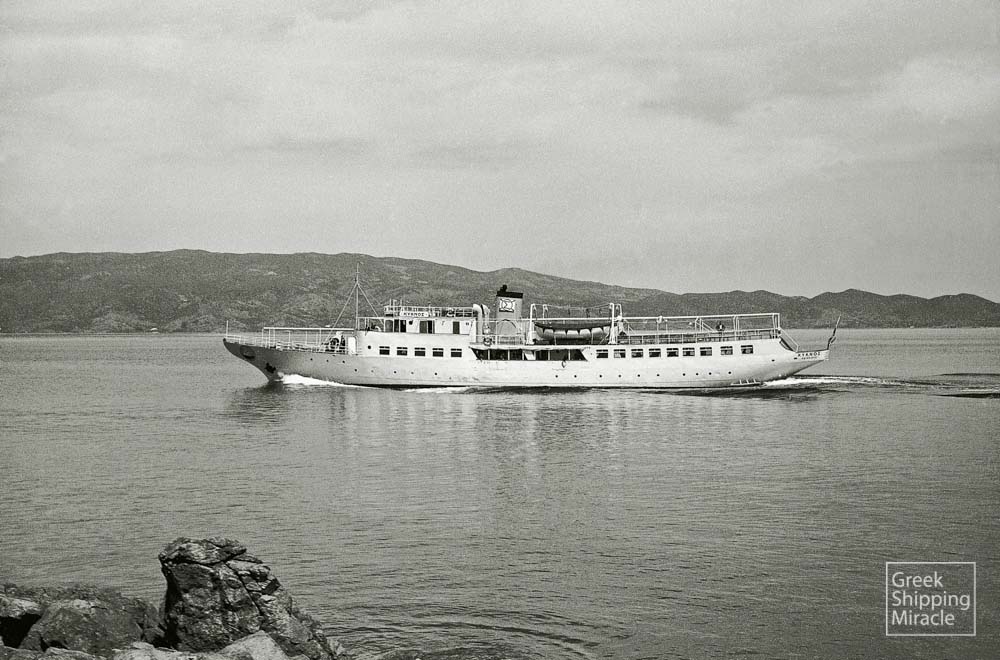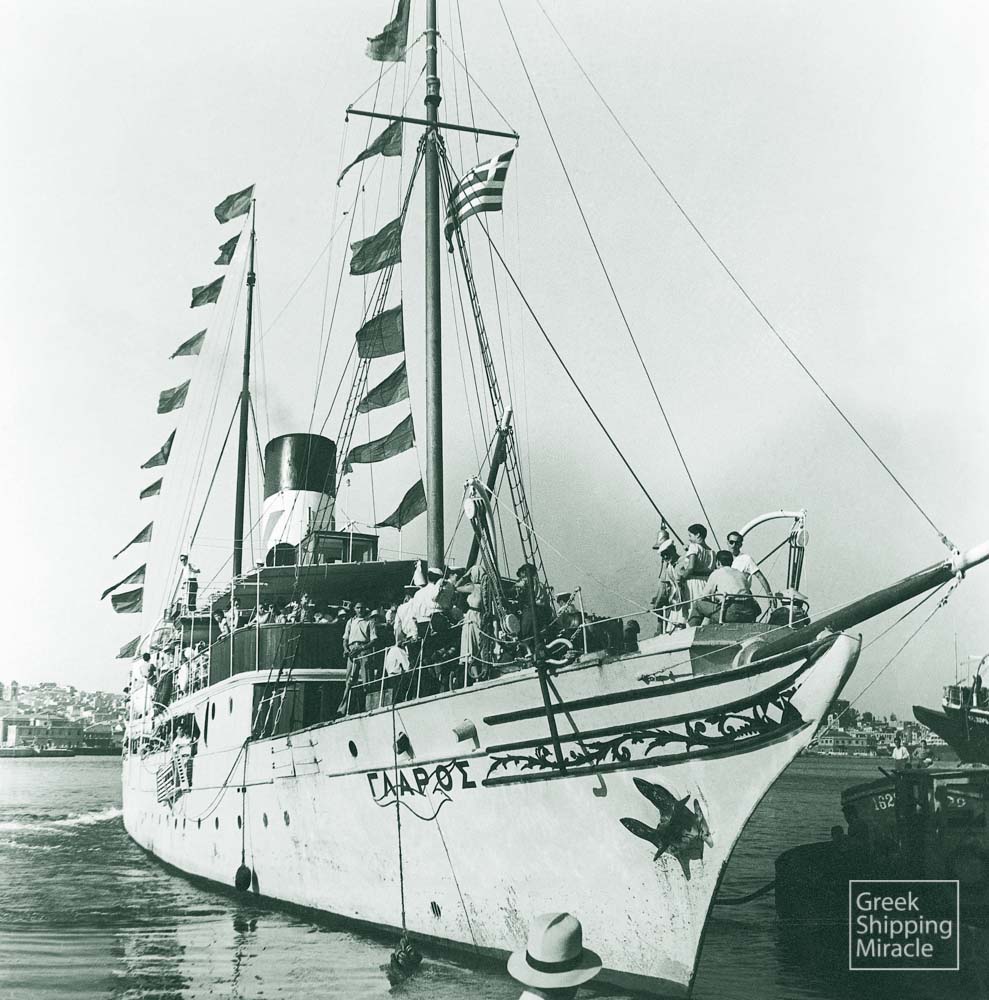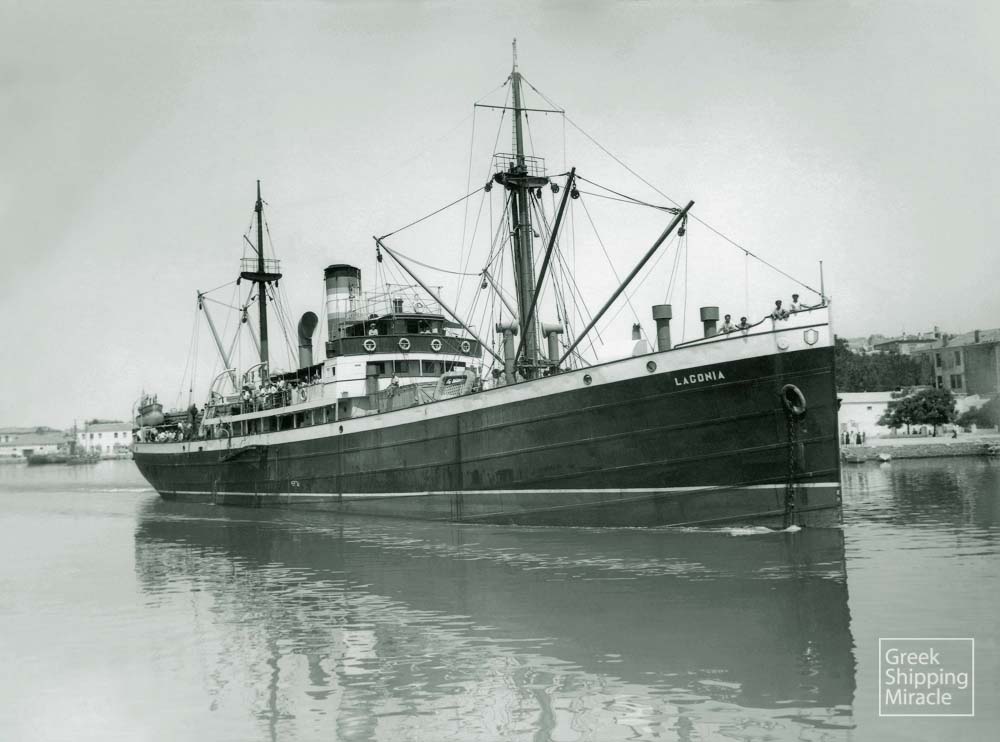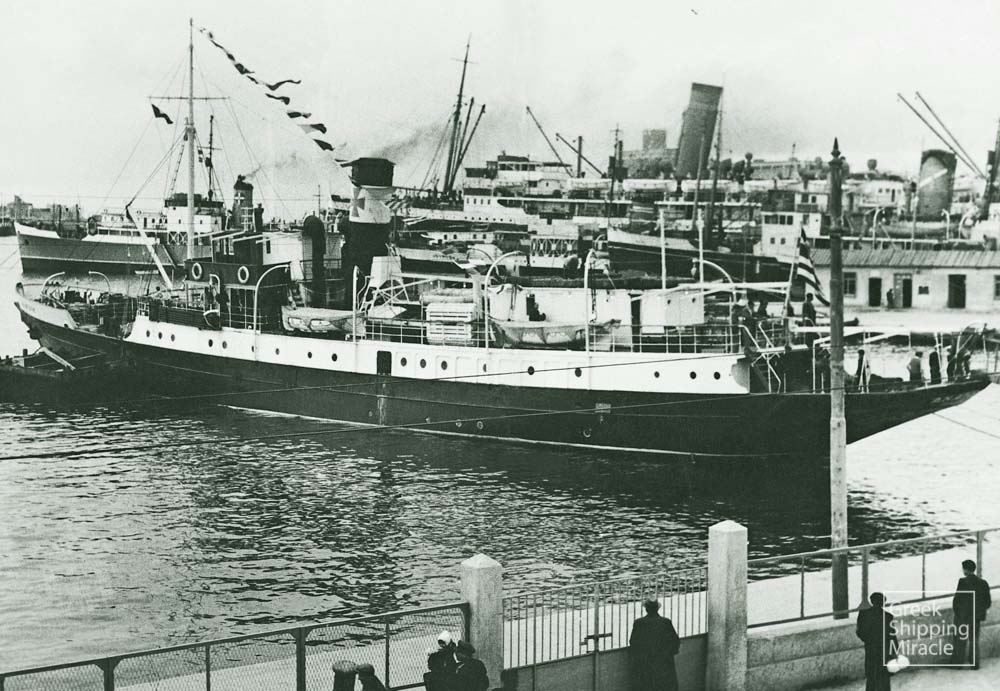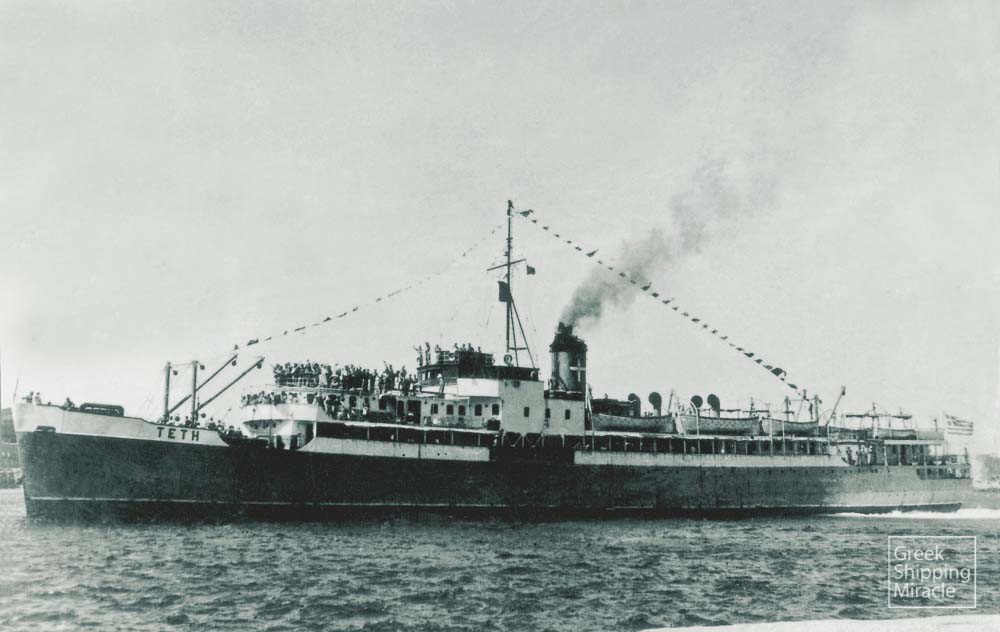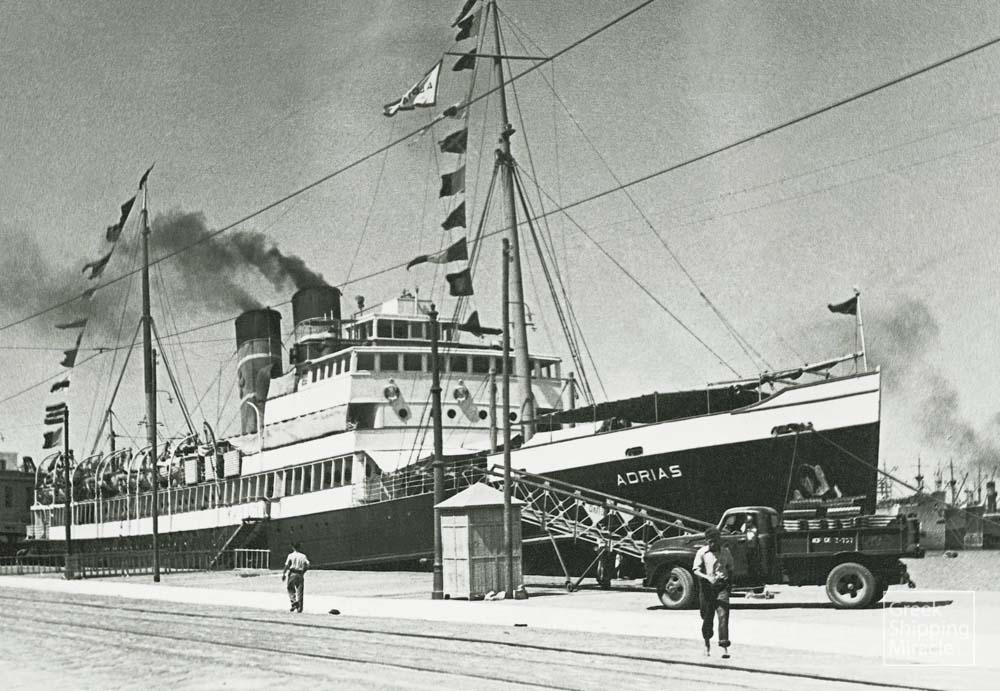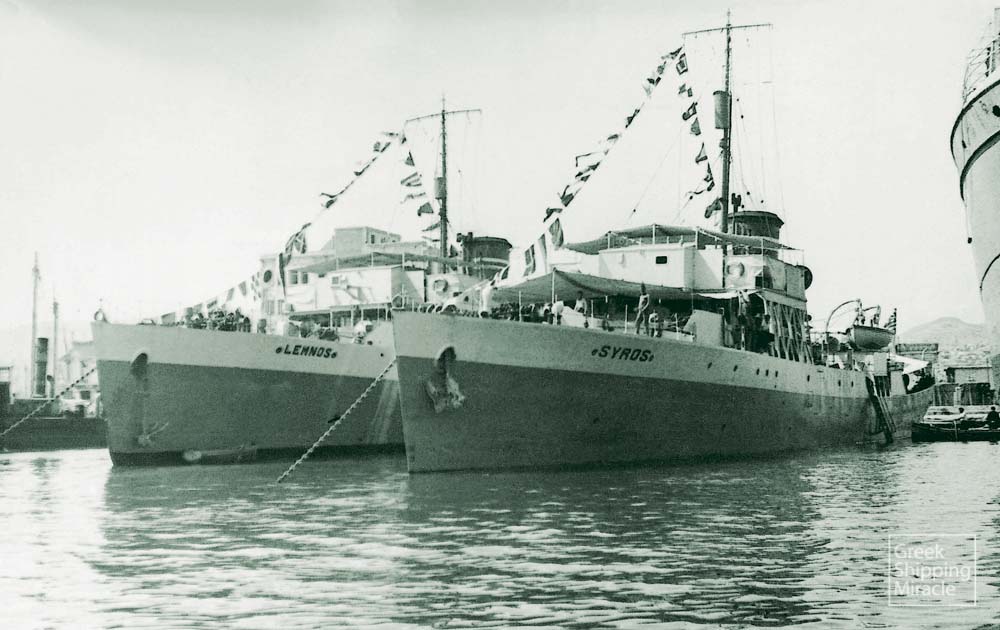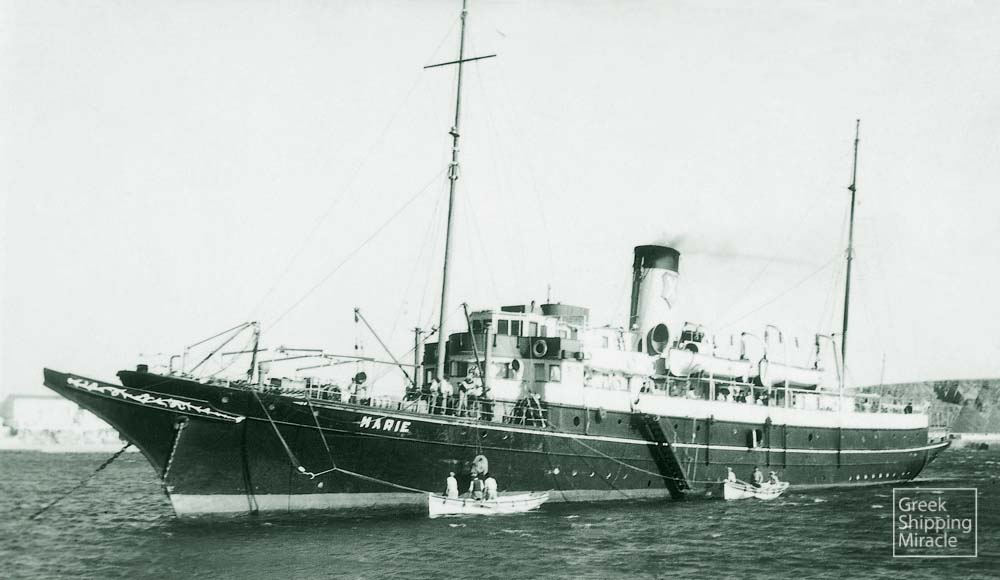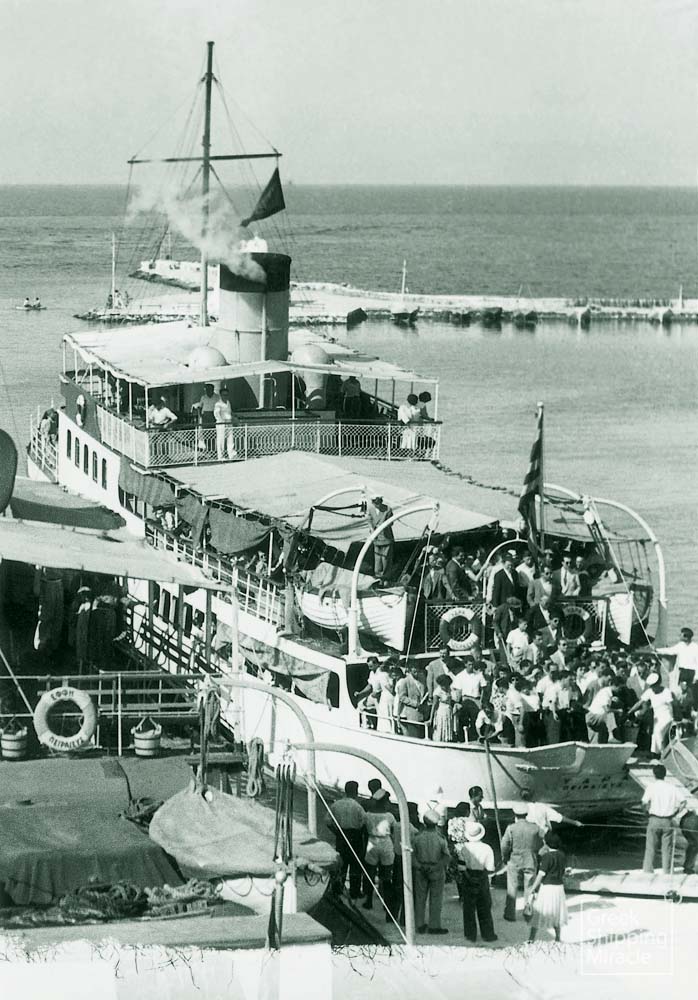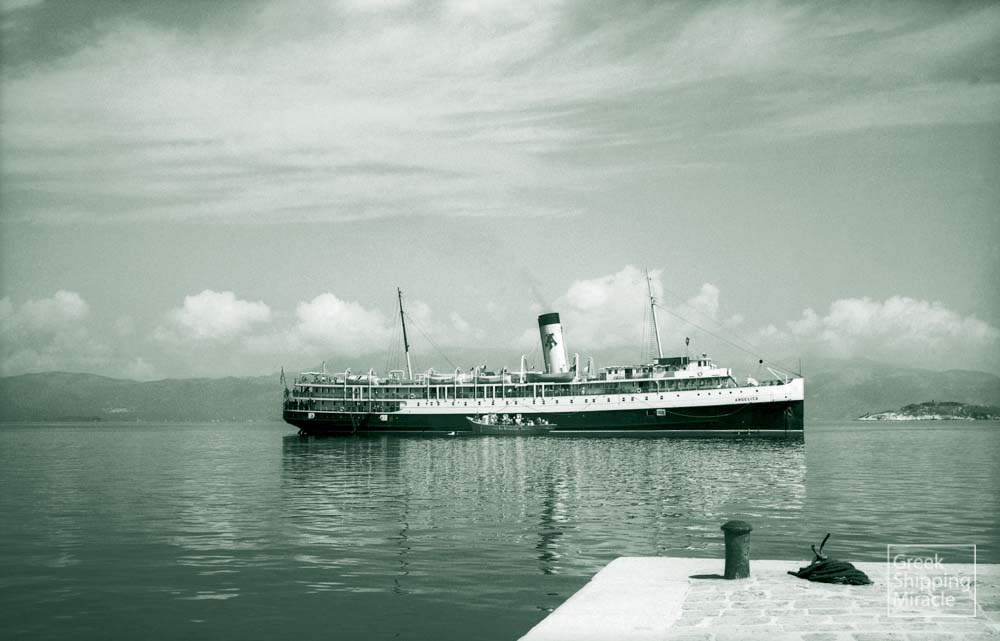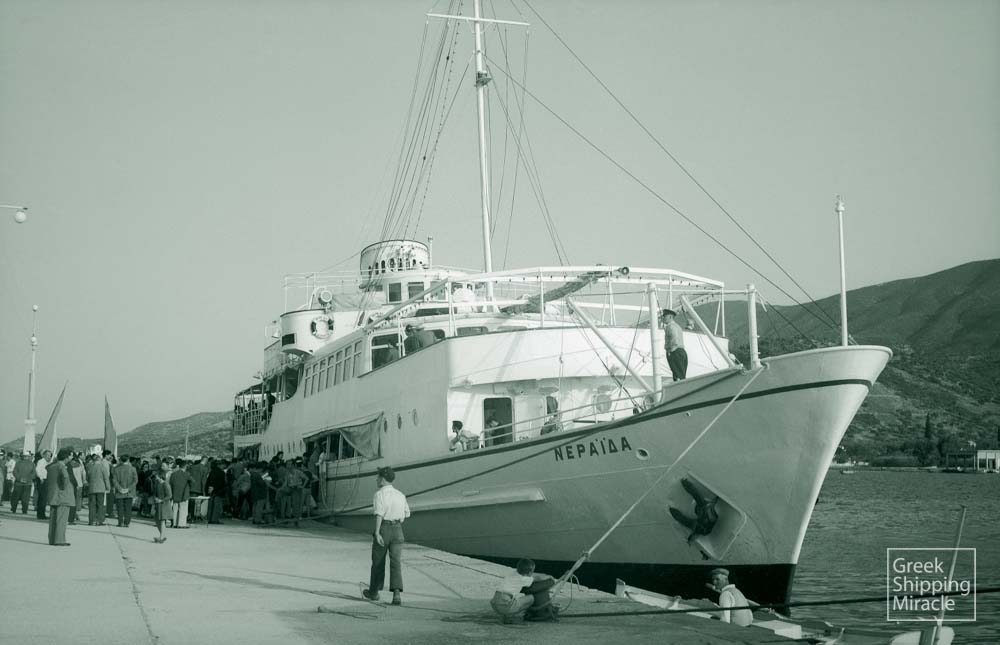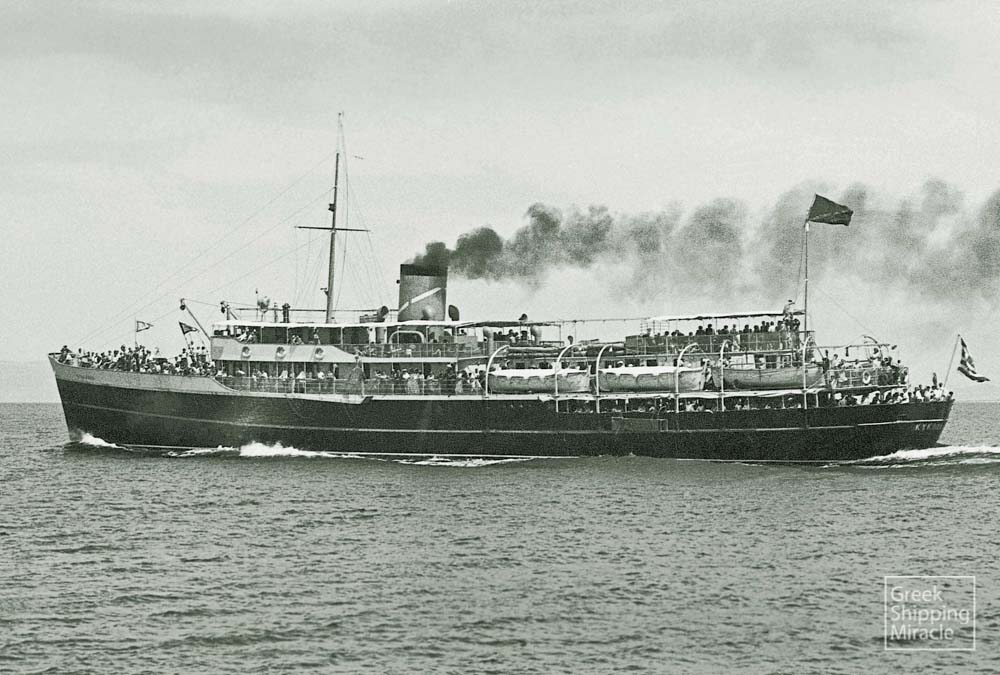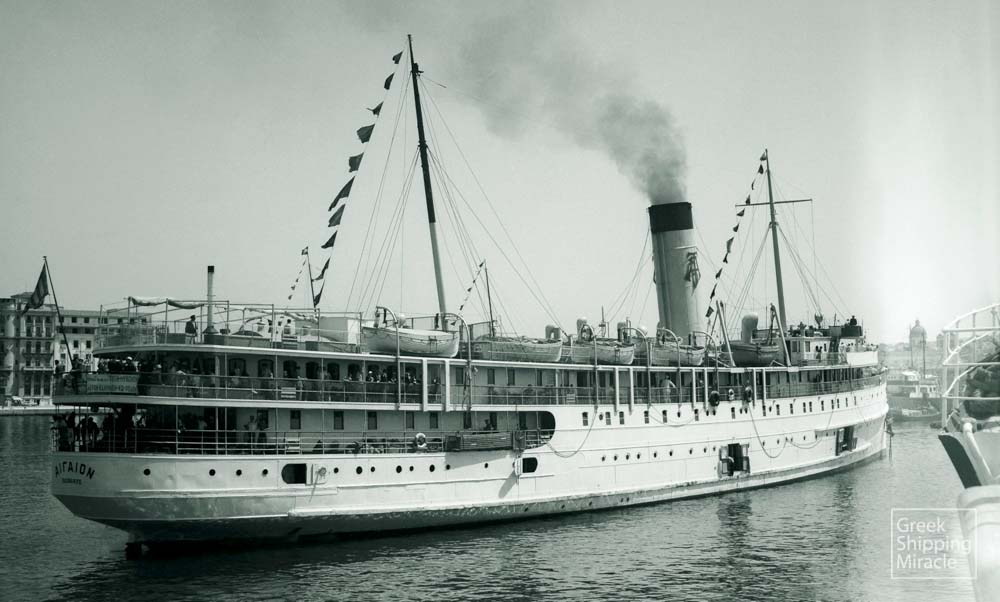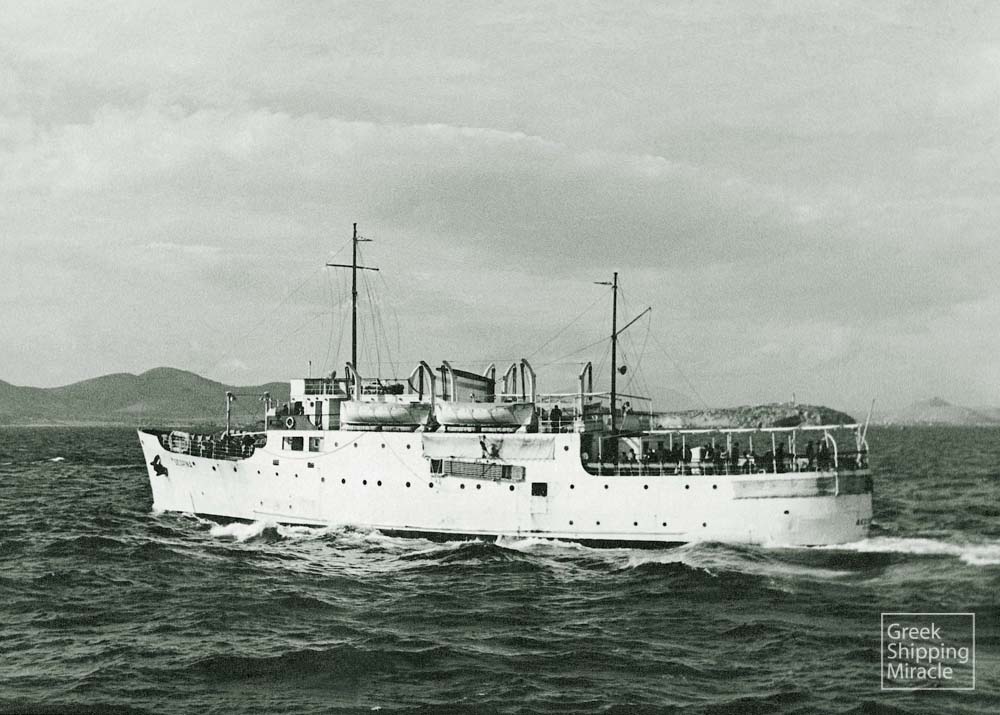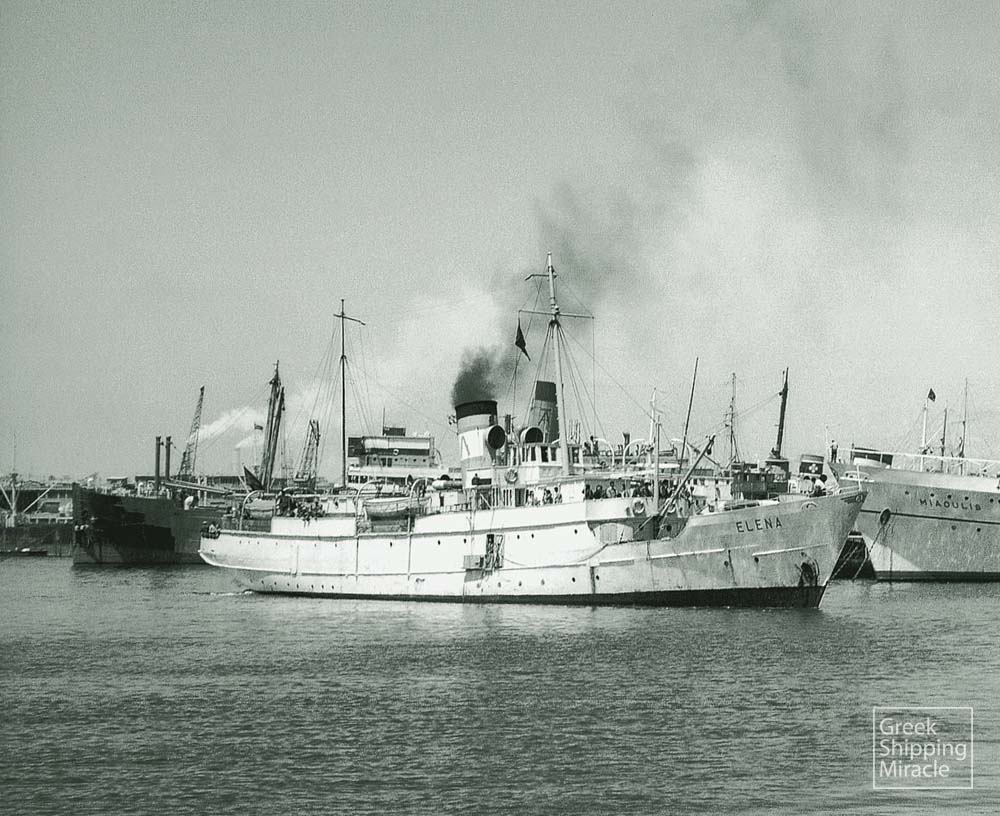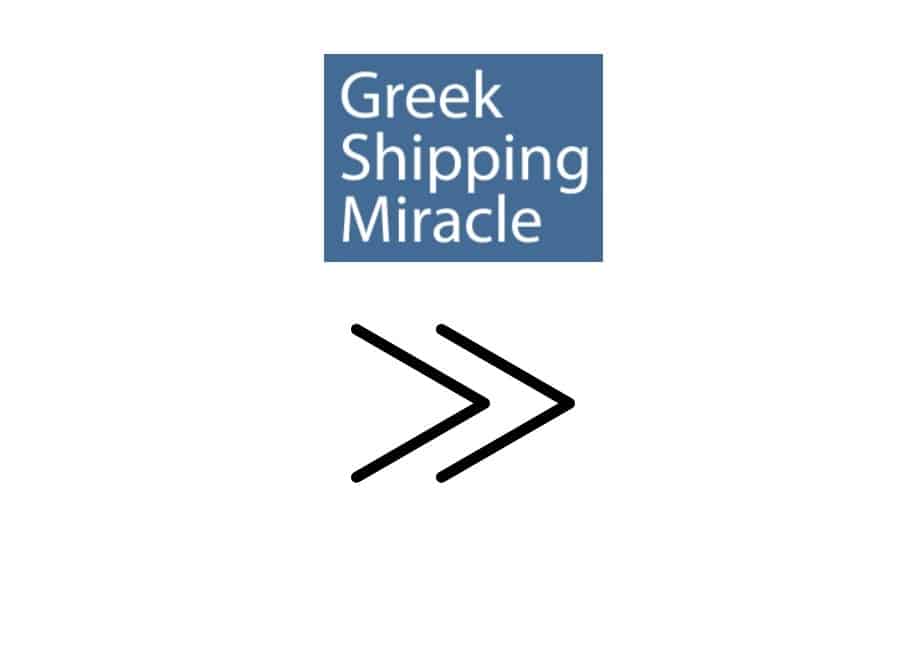The 1896-built NAFSIKA.
HISTORY
Built in 1896 as a yacht by David J. Dunlop & Co., Glasgow, UK. Initial name CHRISTINE, British flag. Subsequently sold to James Dredging Towage & Transport Co. Ltd. and renamed CORYCIA. Acquired by Eleftherios Velliotis and Panaghis Zarifis in 1920, renamed PANAGHIS and placed under Greek flag. Sold to Alexandros G. Yannoulatos in 1923 and renamed NAFSIKA. Sold to Parnassis Steamship Co. of Efthymios T. Stoforos in 1924. Requisitioned by the Greek Government in November 1940. On May 23, 1941, hit during a German air-raid in Suda Bay and sank. Eventually raised after the end of the war and deployed on the Greek coastal service. Broken up in 1952. (1/144)The 1903-built ELENI.
HISTORY
Built in 1903 by Société Anonyme John Cockerill, Hoboken, Belgium, for Russian Transport & Insurance Co. Initial name TSCHERNOMORE, Russian flag. Requisitioned by the Russian Navy in March 1916 and used in Black Sea Transport. Seized by the Germans in 1918 and subsequently returned to her owners. Sold to George M. Embiricos in 1923, renamed ELENI and placed under Greek flag. Seized on April 27, 1941 by the Germans, renamed KONSTANZ and used as a hospital ship. Captured by the British Navy in May 19, 1943, and taken to Malta. Transferred to the Greek Government after the end of the war, however a legal issue developed as to whether vessels that had been seized by the enemy and eventually were recaptured by the Allied Forces should be considered as war prize or should be returned to their initial owners. Given back to her owners, Mrs. Ekaterini C. Canaris, née Embiricos, heir of the late G. M. Embiricos in 1948 following long legal procedures. Broken up in Italy in 1952. (2/144)The 1893-built KORYTZA.
HISTORY
Built in 1893 by Fairfield Shipbuilding & Engineering Co., Ltd., Glasgow, UK, for G. & J. Burns Ltd. Ιnitial name HOUND, British flag. Transferred to Burns & Laird Lines, Ltd. in 1922. Sold to Manuilides Navigation Co. Ltd. in 1925, renamed MARY M. and placed under Greek flag. Transferred to Hellenic Coast Lines Ltd. in 1929. Renamed LESBOS in 1933 and KORYTZA in 1942. Taken over by the British Ministry of War Transport in 1945 and placed under British flag. Returned to her owners in 1946 and placed under Greek flag. Broken up in 1949. (3/144)The 1898-built KALAMARA.
HISTORY
Built in 1898 as a yacht by Vickers, Sons & Maxim Ltd., Barrow, UK. Initial name JEANNETTE, British flag. Later renamed SEA NYMPH and subsequently CALA MARA. Acquired by Ioannis A. Drosopoulos, governor of the Bank of Greece, in 1937, renamed KALAMARA and placed under Greek flag. Sold to Nikolaos G. Mavris in 1945 and to Georgios P. Iosifides in 1947. Sold to Georgios N. Vatikiotis and Georgios S. Vatikiotis in 1948. Sold to Touristiki Aktoploia Argosaronikou in 1959 and renamed POROS. Acquired by John S. Latsis and Ioannis Tripos in 1960. Broken up in Perama, Greece, in 1961. (4/144)The 1889-built MESSARIA.
HISTORY
Built in 1889 by W. Lindbergs Mekaniska Verkstads, Stockholm, Sweden, for Angfartygs A/B Gotland. Initial name POLHEM, Swedish flag. Sold to Landskrona Stads Kom. Styr. in 1930 and renamed LANDSKRONA. Sold to Blekinge Angbats A/B in 1941 and renamed BLEKINGE. Aquired by Evangelos P. Nomikos in 1945, renamed MESSARIA and placed under Greek flag. Sold to Antonios L. Diamantopoulos and Mrs. Sgouri D. Thomadis in 1949 and to Panagiotis A. Stefanis in 1950. Sold to Ioannis K. Dimakis in 1966. Deleted from ship registers in 1986. (5/144)The 1890-built EFFIE.
HISTORY
Built in 1890 by Bergsunds Mekaniska Verkstads Aktiebolag, Stockholm, Sweden, for Blekinge Angbats A/B. Initial name RONNEBY, Swedish flag. Acquired by Evangelos P. Nomikos in 1945, renamed EFFIE and placed under Greek flag. Sold to John S. Latsis in 1949. Stranded off Aegina island in 195, declared a constructive total loss and laid up. Sold to Antonios G. Georgiou in 1954, converted into a cargo ship and renamed ANTONIOS. (6/144)The 1905-built HEIMARA.
HISTORY
Built in 1905 by Stettiner Oderwerke Akt. Ges., Stettin, Germany, for Stettiner Dampfsch. Ges. J. F. Braeunlich m.b.H. Initial name HERTHA, German flag. Requisitioned by the German Navy in October 1914 and used as a hospital ship and subsequently as an auxiliary minelayer. Returned to her owners in 1918. Rquisitioned by the German Navy from 1938 to 1945. Transferred to the Greek Government in 1946 in the context of war reparations, repaired and deployed on Greek coastal service as the HEIMARA. On January 19, 1947 sank after striking rocks in the South Evoikos gulf causing the loss of 389 passengers and crew. (7/144)The 1900-built CHALKIDIKI.
HISTORY
Built in 1900 by G. Seebeck A.G., Bremerhaven, Germany, for Hamburg-Amerika Linie. Initial name KEHRWIEDER, German flag. Requisitioned by the German Navy from 1914 to 1918 and used as a hospital ship. Taken over by the French Government in 1919, while returned to her German owners in 1922. Transferred to the Greek Government in 1946 in the context of war reparations and deployed on the Greek coastal service until 1949 as the CHALKIDIKI. Broken up in 1951. (8/144)The 1930-built KYKNOS.
HISTORY
Built in 1930 as a yacht by Bath Iron Works Corp., Bath Maine, USA, for Logan G. Thomson. Initial name SYLVIA, US flag. Requisitioned by the US Navy in 1941 and renamed TOURMALINE with signal letters PY-20. Transferred to the New York-based Greek War Relief Association Inc. in 1946 and renamed ADELPHIC. Acquired by Hellenic Maritime Enterprise Co. Ltd. “Saronikos” in 1947, renamed KYKNOS and placed under Greek flag. Sold to Loucas Matsas in 1977. Broken up in Megara, Greece, in 1981. (9/144)The 1903-built HELIOPOLIS.
HISTORY
Built in 1903 as a yacht by Ailsa Shipbuilding Co. Ltd., Troon, UK, for Kenneth M. Clark. Initial name KATOOMBA, British flag. Sold to Madame Heriot in 1904, renamed SALVATOR and placed under French flag. Sold to Anthony J. Drexel in 1924, renamed SAYONARA and placed under US flag. Sold to Baron Empain in 1930, renamed HELIOPOLIS and placed under Belgian flag. Acquired by the British Admiralty in 1940, while sold to Petros Paschalis in 1946 and placed under Panamanian flag. Acquired by Aegean Steam Navigation (Typaldos Bros.) in 1947, converted into a passenger ship and placed under Greek flag maintaining the same name. Broken up in Perama, Greece, in 1960. (10/144)The 1913-built MOSCHANTHI.
HISTORY
Built in 1913 as a yacht by Hawthorns & Co. Ltd., Leith, UK, for John Nairn. Initial name ST. SERF, British flag. Requisitioned by the British Admiralty and used as a patrol vessel from 1915 to 1919. Acquired by Thos. N. Mordey in 1919 and by Harold Swithinbank in 1923. Sold to Montague S. Napier in 1926 and renamed NOREEN. Sold to Lord Tweedmouth in 1929 and renamed TIERCEL. Requisitioned by the British Admiralty in 1939. Sold to Panamanian interests in 1946 and renamed JUAN. Acquired by Evangelos C. Toyias, Alkiviades C. Toyias, Constantinos A. Georgiades and Antonios A. Loumidis in 1947, converted into a passenger ship and renamed MOSCHANTHI under Greek flag. Acquired by George F. Frangoudakis in 1963. Broken up at Perama, Greece, in 1966. (11/144)The 1908-built SOFIA TOYIA.
HISTORY
Built in 1908 as a yacht by Day, Summers & Co., Ltd., Southampton, UK, for Duc de Valencay. Initial name SAGITTA, British flag. Requisitioned by the British Admiralty from 1914 to 1918 and used as an armed yacht. Acquired by Edward D. Morton in 1920. Requisitioned by the British Admiralty in November 1939, while taken over by the Ministry of War Transport in 1941. Sold to Lucinda Navigation Ltd. in 1946 and placed under Panamanian flag. Sold to John Toyias in 1947, renamed SOFIA TOYIA and placed under Greek flag. Sold to Evangelos I. Tseppas in 1949 and renamed VARVARA TSEPPA. Sold to Nicolaos Diapoulis in 1950 and renamed ANDROS. Broken up at Perama, Greece, in 1962. (12/144)The 1902-built KARYSTOS.
HISTORY
Built in 1902 as a yacht by D. & W. Henderson & Co. Ltd., Glasgow, UK, for Sir F. H. Anstruther-Gough-Calthorpe. Initial name OMBRA, British flag. Acquired by John Toyias and Evangelos Tseppas in 1947, renamed KARYSTOS and placed under Greek flag. Sold at auction to Evangelos C. Toyias in 1958 and renamed CONSTANTINOS. Broken up in Piraeus, Greece, in 1960. (13/144)The 1943-built CADIO.
HISTORY
Built in 1943 as a corvette by The Collinwood Shipyards Ltd., Collingwood, Ontario, Canada, for the Canadian Navy. Initial name OWED SOUND, Canadian flag. Acquired by Cadia Compania de Navegacion S.A. in 1946, converted into a passenger ship, renamed CADIO and placed under Panamanian flag. Transferred to Cadio G. Sigalas in 1947 and placed under Greek flag, maintaining the same name. Transferred to Teti G. Mamai, née Sigalas, in 1950, while the 49% of the owning shares were taken over by Compania Navegacion Ripa S.A. de Panama in 1952. Laid-up in mid-1950s and broken up in Piraeus, Greece, in 1964. (14/144)The 1904-built GLAROS.
HISTORY
Built in 1904 as a yacht by Scott's Shipbuilding & Engineering Co. Ltd., Greenock, UK, for Wyndam Francis Cook. Initial name BERYL, British flag. Acquired by Lord Hollenden in 1911 and renamed LORNA. Requisitioned by the British Admiralty from 1914 to 1919 and used as an auxiliary patrol vessel. Subsequently sold to Sir Walter R. Preston. Requisitioned by the British Admiralty from September 1939 to May 1941 and used as an armed boarding vessel. Sold to G. Gounaris and N. Maris after the end of WWII, renamed THESSALIA and placed under Panamanian flag. Acquired by Kavounides Shipping Co. Ltd. in 1947, converted into a passenger ship, renamed GLAROS and placed under Greek flag. In December 12, 1966 she sank following collision with the laid-up steamship RITA in Salamis island, Greece. Subsequently refloated and broken up in 1969. (15/144)The 1925-built HERAKLEION (depicted with subsequent name LACONIA).
HISTORY
Built in 1925 as a cargo ship by Norderwerft A.G., Hamburg, Germany, for Bugsier Reed. & Bergungs A.G. Initial name WIEDAU, German flag. Taken over by the British Ministry of Transport in 1945, renamed EMPIRE CONTRACT and placed under British flag. Transferred to the Greek Government in the same year in the context of war reparations, converted into a passenger/cargo ship, renamed HERAKLEION and placed under Greek flag. Sold to Ioannis Tsengas and Spyros Bilinis in 1948 and renamed LACONIA. Sold to Hellenic Levant Lines in 1954 and placed in liner service. Sold to Sinai Manganese Co. in 1965, renamed MANGANESE and placed under Egyptian flag. (16/144)The 1894-built IONION.
HISTORY
Built in 1894 by Fevigs Jernskibsbyggeri, Fevig, Norway for Arendals Dampskibsselskab. Initial name DRONNINGEN, Norwegian flag. Transferred to Det Helgelandske Dampskibsselskab in 1946. Acquired by Aegean Steam Navigation (Typaldos Bros.) in 1948, renamed IONION and placed under Greek flag. Broken up in Piraeus, Greece, in 1963. (17/144)The 1899-built LUCINDA.
HISTORY
Built in 1899 as a yacht by Ramage & Ferguson Ltd., Leith, UK, for A. R. & J. M. Sladen. Initial name SHEMARA, British flag. Sold to the Government of New South Wales in the same year, renamed VICTORIA and placed under Australian flag. Sold to Camper & Nicholson Ltd. in 1905, renamed SHEMARA and placed under British flag. Requisitioned by the British Admiralty from 1914 to 1919 and used as an auxiliary patrol vessel. Sold to Sir Charles D. Burney in 1933 and renamed LUCINDA. Sold to Lucinda Cia. Panamena de Navegacion S.A. in 1946 and placed under Panamanian flag. Acquired by Mikes N. Filinis, Nikolaos M. Filinis, Petros Paramythiotis and Georgios Vougiouklis in 1947, converted into a passenger ship and placed under Greek flag maintaining the same name. Broken up in Italy in 1952. (18/144)The 1897-built ANATOLI.
HISTORY
Built in 1897 as a yacht by Scott’s Shipbuilding & Engineering Co. Ltd., Greenock, UK, for William Clark. Initial name TUSCARORA, British flag. Acquired by Walter & O. B. Jennings in 1901 and placed under US flag. Sold to Ramon de la Sota in 1911, renamed GIOIZEKO IZARRA and placed under Spanish flag. Acquired by Godfrey H. Williams in 1923, renamed again TUSCARORA and placed under British flag. Requisitioned by the British Admiralty from 1940 to 1946 and used as an anti-submarine patrol vessel. Sold to Bienvenido Steamship Co. Ltd. (J. Livanos & Sons Ltd.) in 1946, converted into a passenger ship, renamed ANATOLI and placed under Panamanian flag. Acquired by Antonios L. Diamantopoulos and Georgios P. Pyliaros in 1948 and placed under Greek flag maintaining the same name. Sold to Michail N. Ezonis in December 1950. Sold to Nicolaos, Ioannis and Leonidas G. Domestinis, Dimitrios N. Angelopoulos and Achilles M. Cambanis in 1951, converted into a cargo ship and renamed EVGENIA. Acquired by Nicolaos Moundreas & Co. in 1959 and by Ar. Georgakakos & Co. in 1961. Sold to foreign interests in 1968, renamed ALHELAL and placed under Saudi Arabian flag. Sank on October 4, 1968, under adverse weather conditions. (20/144)The 1943-built TETI.
HISTORY
Built in 1943 as a frigate by Canadian Vickers Ltd., Montreal, Canada. Initial name HMS LOSSIE, British flag. Acquired by Cadio Cia. de Navegacion of the G. Sigalas Sons group in 1946, converted into a passenger ship, renamed TETI and placed under Panamanian flag. Placed under Greek flag in 1949. Sold to Aegean Steam Navigation (Typaldos Bros.) in 1954, while extensively rebuilt in 1956 and renamed ADRIATIKI. Laid up in Perama in 1967. On April 6, 1973 she broke adrift due to a strong gale and sank on the following day at Drapetsona, Greece. (21/144)The 1907-built PINDOS II.
HISTORY
Built in 1907 as a yacht by Ailsa Shipbuilding Co. Ltd., Troon, UK, for William K. Millar. Initial name MAID OF HONOUR, British flag. Sold to Marion G. Thorton in 1913. Requisitioned by the British Admiralty from 1915 to 1919 and used as an auxiliary patrol vessel. Sold in 1922 to Courtney C. E. Morgan and renamed SYLVANA. Sold to Bury Court Shipping Co. Ltd. (G. Potamianos) in 1947. Transferred to Epirotiki Steamship Co. Georgios Potamianos S.A. in 1948, converted into a passenger ship and placed under Greek flag. Renamed PINDOS II in 1949, while in 1951 acquired by Panos D. Papaoikonomou, Ioannis D. Tripos, Georgios N. Vatikiotis and Manthos P. Vettas. Acquired at auction by the Commercial Bank of Greece in 1964. Sold to Panagiotis P. Thanopoulos in 1965, renamed ARIS and PINDOS subsequently. Acquired again by the Commercial Bank of Greece in 1968. (22/144)The 1893-built ADRIAS.
HISTORY
Built in 1893 by Harland & Wolff Ltd., Belfast, UK, for Belfast Steamship Co. Ltd. Initial name MAGIC, British flag. Renamed CLASSIC in 1919. Sold to City of Cork Steam Packet Co. Ltd. in 1925, renamed KILLARNEY and placed under Irish flag. Sold to Coast Lines Ltd. in 1932 and placed under British flag. Requisitioned by the British Admiralty from 1940 to 1946. Acquired by Bury Court Shipping Co. Ltd. (G. Potamianos) in 1947 and renamed ATTIKI maintaining the British flag. Transferred to Epirotiki Steamship Co. Georgios Potamianos S.A. in 1948, renamed ADRIAS and placed under Greek flag. On October 6, 1951 driven ashore on Falconera island, Greece, and became a total loss. (23/144)The 1941-built SYROS.
HISTORY
Built in 1941 as a corvette by Harland & Wolff Ltd., Belfast UK. Initial name BERGAMOT, British flag. Acquired in 1946 by the Greek Government, renamed SYROS and placed under Greek flag. Acquired by Kavounides Shipping Co. Ltd. in 1950, converted into a passenger ship and renamed DELPHINI. Renamed EKATERINI in 1955. Broken up in Perama, Greece, in 1976. (24/144)The 1911-built MARIE.
HISTORY
Built in 1911 as a yacht by J. I. Thornycroft & Co. Ltd., Southampton, UK, for Henry J. Mason. Initial name MARYNTHEA, British flag. Requisitioned by the British Admiralty from 1915 to 1919. Sold to Sir Arthur P. du Cros in 1919 and renamed EMERALD. Sold to H. Gordon Selfridge in 1926 and renamed CONQUEROR. Requisitioned by the British Admiralty from September 1939 to 1945. Sold to Lamyra Cia. de Vapores S.A. in 1947, converted into a passenger ship, renamed PATRIS and placed under Panamanian flag. Transferred to Georgios P. Hadoulis & Co. in 1948, renamed MARIE and placed under Greek flag. Sold to Evangelos C. Toyias in 1949 and renamed COSTAKIS TOYIAS in 1950. Acquired by Lazaros S. Lagas in 1958 and renamed MARILENA. Extensively rebuilt in 1961. Broken up in Chalkis, Greece, in 1979 after a long lay-up period. (25/144)The 1906-built NIKI [depicted with subsequent name HYDRA (Michael Matantos archive)].
HISTORY
Built in 1906 as a tug by Garston Graving Dock and Shipbuilding Co. Ltd., Garston, UK, for Mersey Towing Company Ltd. Initial name BISON, British flag. Acquired by Velissaris C. Katoulas in 1946, converted into a passenger ship, renamed NIKI and placed under Greek flag. Transferred to the heirs of V. C. Katoulas in 1948. Sold to John S. Latsis in 1949 and renamed HYDRA in 1950. Sold to Nikolaos G. Lambiris in 1954, converted into a cargo ship and renamed NIKOLAS L. Sold to Antonios and Ioannis Mavrellos in 1958. Acquired at auction by Vassilios Zavitsanos in 1963 and renamed AGIOS GEORGIOS. On October 5, 1968 she sank off Mytilene island. (26/144)The 1910-built ANGELICA.
HISTORY
Built in 1910 by Fairfield Shipbuilding & Engineering Co. Ltd., Glasgow, UK, for the Canadian Pacific Railway Co. Initial name PRINCESS ADELAIDE, Canadian flag. Acquired by Aegean Steam Navigation (Typaldos Bros.) in 1949, renamed ANGELICA and placed under Greek flag. Broken up in 1966 in Italy. (27/144)The 1939-built LAURANA (depicted with subsequent name NERAIDA).
HISTORY
Built in 1939 by Cantieri Navali del Quarnaro S.A., Fiume, Italy for Soc. Fiumana di Navigazione. Initial name LAURANA, Italian flag. Sold to John S. Latsis in 1949 and placed under Greek flag maintaining the same name, while renamed NERAIDA in 1950. Transferred to Hellenic Coastal Transport S.A. in 1970 and to Neraida Shipping Co. in 1978. The ship operates as a floating museum since 2010. (28/144)The 1941-built ALEXANDRA.
HISTORY
Built in 1941 as a corvette by Alexander Hall & Co., Aberdeen, UK. Initial name COLTSFOOT, British flag. Sold in 1946 to Divisa Compania de Vapores, renamed ALEXANDRA under Panamanian flag and converted into a passenger ship. Acquired in 1949 by Michail N. Piangos. Sold in 1950 to Piraiki Steamship Co. of G. Pyliaros & A. Diamantopoulos and placed under Greek flag maintaining the same name. Acquired in 1952 by N. Diamantis. Sold to Erietta A. Papageorgiou and Elli G. Thomopoulos in 1951. Acquired in 1952 by N. Diamantis. Sold in 1952 to Foustanos Brothers and renamed ERMOUPOLIS in 1953. On November 20, 1954, stranded on rocks off the port of Syros island due to heavy fog and became a total loss. (29/144)The 1943-built CYCLADES.
HISTORY
Built in 1943 as a minesweeper (algerine class) by Toronto Shipbuilding Co. Ltd., Canada. Initial name PERSIAN, British flag. Left over in ODISY after the end of the War. Acquired in 1950 by John Toyias, renamed CYCLADES and was converted into a passenger ship. Transferred to John Toyias Steamship Co. S.A. in 1954. Taken over at auction by the National Bank of Greece in 1958. Acquired in 1958 by the Ionian Steamship Navigation Co. Ltd. (Petros Potamianos) and renamed ADRIAS. Taken over in 1961 by National Bank of Greece, placed under the temporary management of the Kavounides Shipping Co. Ltd. and renamed ATHINA. Sold in the same year to the above group and renamed POLIKOS. Broken up in Piraeus in 1974. (30/144)The 1911-built AEGEON.
HISTORY
Built in 1911 by Swan, Hunter & Wigham Richardson Ltd., Newcastle, UK for Canadian Pacific Railway Co. Initial name PRINCESS ALICE, Canadian flag. Acquired in 1949 by Aegean Steam Navigation (Typaldos Bros.), renamed AEGEON and placed under Greek flag. On December 2, 1966, while she was towed from Piraeus to Savona, Italy, in order to be delivered to local breakers, she grounded off Civitavecchia during heavy storm. (31/144)The 1943-built DESPINA.
HISTORY
Built in 1943 as a Navy escort and patrol vessel by Pullman Standard Car Manufacturing Co., Chicago, USA. Initial name KILMORE, British flag. Left over in Greece after the end of WWII and she became the property of ODISY. Acquired in 1950 by Foustanos Brothers, converted into a passenger ship and renamed DESPINA under Greek flag. Sold in 1969 to Georgios Kousouniadis & Co. and renamed EVANGELISTRIA. Broken up in Elefsis, Greece, in 1980. (32/144)The 1904-built AVRA (depicted with subsequent name ELENA).
HISTORY
Built as a yacht in 1904 by Scott's Shipbuilding & Engineering Co. Ltd., Greenock, UK. Initial name GRIANAIG, British flag. Requisitioned by the British Admiralty in 1914 and used as an auxiliary patrol vessel, while used for anti-submarine patrol service in 1916 and later on as a hospital ship. Returned to her owner Earl of Dunraven in 1919. Sold in mid-1920s to A.J. Drexel, Jr. and renamed ALOMA. Subsequently acquired by Aymar Johnson, renamed ENCHANTRESS and placed under US flag. Sold in 1937 to Moss S. Myers and renamed LADY SHAHRAZAD under British flag. Requisitioned by the British Admiralty in September 1939 and used for anti-submarine patrol service. Sold in 1946 to Compania Maritima Corthi S.A., converted into a passenger ship and renamed ANTONIO under Panamanian flag. Acquired in 1948 by Giannoulis Z. Gounaris and renamed AVRA under Greek flag. Sold in 1950 to Lazaros S. Lagas and renamed ELENA in 1951. Broken up in Greece in 1959. (33/144)The 1952-built MIAOULIS.
HISTORY
Built in 1952 by Cantieri Riuniti dell' Adriatico, Monfalcone, Italy for the Greek Government in the context of Italy's war reparations to Greece. Acquired on delivery by Petros M. Nomikos Ltd. Sold in 1973 to Athenian Cruises S.A. and in 1976 to Miaoulis Shipping Ltd. of the Strintzis group. Acquired in 1977 by Agapitos Brothers. Broken up in Pakistan in 1988. (34/144)The 1952-built KANARIS.
HISTORY
Built in 1952 by Cantieri Riuniti dell' Adriatico, Monfalcone, Italy for the Greek Government in the context of Italy's war reparations to Greece. Acquired on delivery by Petros M. Nomikos Ltd. Sold in 1973 to Maleas Shipping Co. Ltd of Stathakis Bros. and V. Manousos and transferred to Kanaris Shipping S.A. in 1979. Sold in 1980 to Forecast Line Co. Ltd. Renamed TRAFALGAR in 1981 but never traded under this name. Broken up in Elefsis, Greece, in 1984. (35/144)
GREEK COASTAL SHIPPING 1945-2000
After its liberation in 1944, the Greek state got delivery of some elderly vessels as part of war reparations, which were placed in various coastal routes. One of those ships, the HEIMARA, sunk in 1947 leading to one of the worst maritime disasters in Greek waters. In the following years, Greece agreed with the Italian government the construction of a series of four passenger ships, which, however, cost much more than their actual value.
Essentially, the entire post-war development of Greek coastal shipping –particularly during the first two post-war decades– was undertaken by only a few entrepreneurs, without the participation or the support of the state. Starting from scratch, they acquired old British yachts and warships and converted them into passenger vessels, assisting in Greece’s reconstruction and in several cases helping their home islands to establish a regular and reliable connection with the mainland.
However, no company lasted long. Most ceased operations having suffered significant losses, while others exited the coastal sector opting to focus on other shipping markets.
Despite adversities, the Greek passenger coastal fleet managed to gradually grow with the addition of several high-specification vessels capable of efficiently serving Greece’s complex island network. Moreover, the listing of the largest ferry companies on the Athens Stock Exchange facilitated the ordering of several newly-built units.
Greek passenger coastal shipping has made notable progress over the past three decades, with the quality of the fleet currently ranking above the EU average. Nevertheless, some of the sector’s weaknesses, which have negatively affected its growth over the years, still remain.
This section presents all passenger ships placed on coastal routes departing from the port of Piraeus from 1945 up to 2000.

